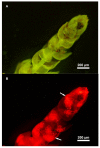Do Nitrogen and Phosphorus Additions Affect Nitrogen Fixation Associated with Tropical Mosses?
- PMID: 37050067
- PMCID: PMC10097241
- DOI: 10.3390/plants12071443
Do Nitrogen and Phosphorus Additions Affect Nitrogen Fixation Associated with Tropical Mosses?
Abstract
Tropical cloud forests are characterized by abundant and biodiverse mosses which grow epiphytically as well as on the ground. Nitrogen (N)-fixing cyanobacteria live in association with most mosses, and contribute greatly to the N pool via biological nitrogen fixation (BNF). However, the availability of nutrients, especially N and phosphorus (P), can influence BNF rates drastically. To evaluate the effects of increased N and P availability on BNF in mosses, we conducted a laboratory experiment where we added N and P, in isolation and combined, to three mosses (Campylopus sp., Dicranum sp. and Thuidium peruvianum) collected from a cloud forest in Peru. Our results show that N addition almost completely inhibited BNF within a day, whereas P addition caused variable results across moss species. Low N2 fixation rates were observed in Campylopus sp. across the experiment. BNF in Dicranum sp. was decreased by all nutrients, while P additions seemed to promote BNF in T. peruvianum. Hence, each of the three mosses contributes distinctively to the ecosystem N pool depending on nutrient availability. Moreover, increased N input will likely significantly decrease BNF associated with mosses also in tropical cloud forests, thereby limiting N input to these ecosystems via the moss-cyanobacteria pathway.
Keywords: cyanobacteria; ecosystem ecology; global change; mosses; nitrogen fixation; nutrient limitation; phosphorus; tropical cloud forest.
Conflict of interest statement
The authors declare no conflict of interest.
Figures






Similar articles
-
Rapid response of moss-associated nitrogen fixation to nutrient additions in tropical montane cloud forests with different successional stages.Biogeochemistry. 2025;168(1):12. doi: 10.1007/s10533-024-01195-3. Epub 2025 Jan 4. Biogeochemistry. 2025. PMID: 39764295 Free PMC article.
-
Molybdenum and phosphorus limitation of moss-associated nitrogen fixation in boreal ecosystems.New Phytol. 2017 Apr;214(1):97-107. doi: 10.1111/nph.14331. Epub 2016 Nov 24. New Phytol. 2017. PMID: 27883187
-
Biological nitrogen fixation, diversity and community structure of diazotrophs in two mosses in 25 temperate forests.Environ Microbiol. 2024 Jan;26(1):e16555. doi: 10.1111/1462-2920.16555. Epub 2023 Dec 26. Environ Microbiol. 2024. PMID: 38148519
-
Biological nitrogen fixation across major biomes in Latin America: Patterns and global change effects.Sci Total Environ. 2020 Dec 1;746:140998. doi: 10.1016/j.scitotenv.2020.140998. Epub 2020 Jul 19. Sci Total Environ. 2020. PMID: 32763600 Review.
-
Biotic and abiotic controls of nitrogen fixation in cyanobacteria-moss associations.New Phytol. 2022 Aug;235(4):1330-1335. doi: 10.1111/nph.18264. Epub 2022 Jun 10. New Phytol. 2022. PMID: 35687087 Review.
Cited by
-
Rapid response of moss-associated nitrogen fixation to nutrient additions in tropical montane cloud forests with different successional stages.Biogeochemistry. 2025;168(1):12. doi: 10.1007/s10533-024-01195-3. Epub 2025 Jan 4. Biogeochemistry. 2025. PMID: 39764295 Free PMC article.
References
-
- Bellenger J.P., Darnajoux R., Zhang X., Kraepiel A.M.L. Biological nitrogen fixation by alternative nitrogenases in terrestrial ecosystems: A review. Biogeochemistry. 2020;149:53–73.
-
- Rascio N., La Rocca N. Encyclopedia of Ecology. Elsevier; Amsterdam, The Netherlands: 2018. Biological Nitrogen Fixation. - DOI
-
- Porada P., Weber B., Elbert W., Pöschl U., Kleidon A. Estimating impacts of lichens and bryophytes on global biogeochemical cycles. Glob. Biogeochem. Cycles. 2014;28:71–85.
-
- Ackermann K., Zackrisson O., Rousk J., Jones D.L., DeLuca T.H. N2 Fixation in Feather Mosses is a Sensitive Indicator of N Deposition in Boreal Forests. Ecosystems. 2012;15:986–998. doi: 10.1007/s10021-012-9562-y. - DOI
Grants and funding
LinkOut - more resources
Full Text Sources

